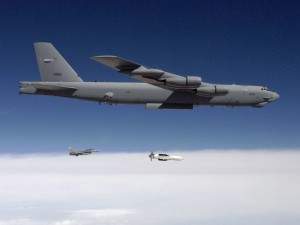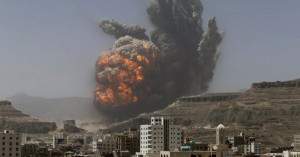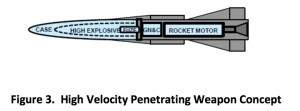It was a rocket-powered bunker buster
May 11, 2023 by Thomas Wictor
I should’ve joined the military. The reason I didn’t is that I’ve suffered from irregular heartbeat all my life, and I ruined my right arm in a fall from a tree in 1970. Then I ruined my left arm in high school in 1980. Also, until I was forty-five years old, I was a physical coward. If I’d joined the military, the only place I would’ve been functional is in a think tank. Oh well. Today I realized why the April 20, 2015, explosion at the Yemeni missile base near Faj Attan, Sana’a, was so gigantic. They used a rocket-powered bunker buster.
First, the best video of the explosion.
You can hear antiaircraft canons firing, so a bomber dropped this thing. However, I’ve studied every video available, and there’s no trace of the munition streaking through the air. If it were a huge bomb like the GBU-57A/B Massive Ordnance Penetrator (MOP), you’d be able to see it.
Plenty of videos show bombs hitting their target. Here, for example, you can see GBU-38 JDAMs (joint direct-attack munitions) being dropped. These weigh only 500 pounds (227 kilos) and are 7.3 feet (2.2 meters) long.
I should’ve been able to isolate the Yemen bomb, but it doesn’t appear in any of the videos.
So today it came to me why the munition is invisible and why the debris towers of the impact reached at least 2000 feet (610 meters) in height: The bomb struck the missile base with incredible kinetic energy. It was powered, in other words. I think the weapon came in from the right in this photo, and the explosive filling created the fireball that vented to the left.
The tallest dust-debris towers usually point toward the opposite direction from which the munition came. In the following video, the impacts are purely kinetic, since the munitions are inert.
Here’s a silly, jingoistic Turkish video that ends with imagery of an American weapon, the GBU-28 bunker buster. You can see the GBU-28 at 3:02.
The GBU-28 is 18.6 feet (5.7 meters) long.
In this particular video, the dust-debris towers achieved a terminal height of about 150 feet (46 meters).
The munition that hit the base in Yemen created dust-debris towers at least 2000 feet (610 meters) tall. I’m guessing that the explosive used in that munition was a variant of rocket fuel. Therefore it was a thermobaric munition. The “benefit” (if you pardon my truly repulsive use of the word) of a thermobaric weapon is that it creates a blast effect much greater than that of high-explosive munitions. Another phrase for “blast effect” is shock wave. As you can see in the video, the Yemen explosion knocked a cameraman off his feet from 1.5 miles (2.4 kilometers) away.
I knew that the Israelis wouldn’t have simply built a bomb the size of a jumbo jet in order to create such a huge explosion. Part of what causes dust-debris towers to rise is the kinetic force of the munition hitting the target. If you drop a bomb, it reaches terminal velocity before it hits the ground. The absolute maximum speed of a free-falling aerial munition is about 750 miles per hour (1207 kilometers per hour). That’s nothing.
So today I thought, “I’ll bet the Israelis dropped a rocket-powered bomb that used both the kinetic energy and the explosive power of the munition.”
In tank warfare they fire a sabot (SAY-boh) round. This dart made from depleted uranium operates as a kinetic energy (KE) penetrator. The sabot itself has no explosives in it.
Today I therefore went looking for information on rocket-assisted bunker busters. And guess what? That was the plan all along.
I found the fact sheet for the High Velocity Penetrating Weapon (HVPW) in the AFRL munitions directorate booth at the Air Warfare Symposium a few days ago. The document reveals the USAF has shifted its focus on next-generation penetrator technology on a couple of different levels.
Force is a function of mass multiplied by velocity. Mass is the key design point for the free-falling, 5,000lb GBU-28 bunker buster and the 30,000lb Massive Ordnance Penetrator.
For the next generation penetrator weapon, the AFRL appears to have shifted the focus to velocity. Packing a solid rocket propulsion system “with mission tailored boost and terminal velocities, intelligent fuzing and optimized explosive,” the HVPW blasts into bunkers using speed in place of raw mass…
I asked Lt Gen Jim Kowalski, chief of Global Strike Command, about that the next day. He clarified that Fraser means the next generation bomber will leverage the bunker-buster effect of the massive ordnance penetrator, but not necessarily its mass. In the aforementioned force equation, that implies a shift toward higher speed, although Kowalski declined to confirm that theory.
Folks, it’s not a theory anymore. And it’s not next-generation. The Israelis and their Sunni Arab allies have deployed an HVPW in combat. An HVPW is the only answer to all the questions.
Why such a massive fireball? Why such tall dust-debris towers? Why the gargantuan shock wave? Why no series of secondary explosions?
The article above was written in 2011. Four years measured in mere human lifespans is equivalent to about a decade in terms of Israeli technological development. Add several billion dollars from the Saudis, Emiratis, and Omanis, and four years becomes twenty years. I have no doubt that Israel and her Sunni Arab allies have used an HVPW in combat.
Rulers Snub Arab Summit, Clouding U.S. Bid for Iran Deal
Saudi monarch’s decision signals that the Arab states aren’t on board with nuclear accord
WASHINGTON—Saudi Arabia’s monarch pulled out of a summit to be hosted by President Barack Obama on Thursday, in a blow to the White House’s efforts to build Arab support for a nuclear accord with Iran.
King Salman’s decision appeared to ripple across the Persian Gulf. Bahrain said on Sunday that its ruler, King Hamad bin Isaa Al Khalifa, had opted not to travel to Washington.
The only two monarchs from the six countries confirmed to attend the summit at the White House and the presidential retreat at Camp David, Md., were the emirs of Qatar and Kuwait.
GOOD!
This article viewed 2762 times.






